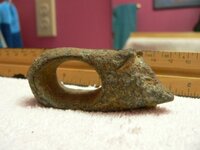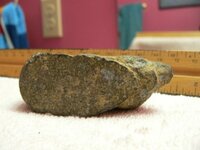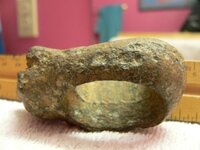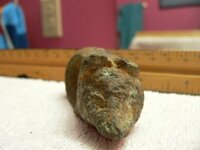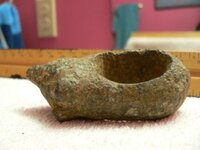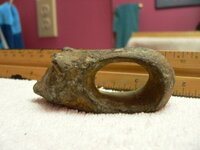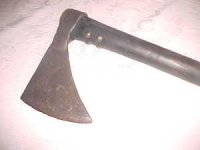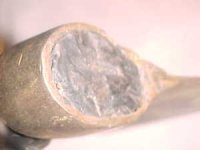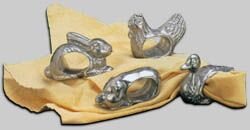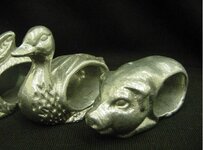Lithophylic
Greenie
I received this item about a year ago from a collector in SC who traded it to me as a "stone pendant". My initial review of the photos he sent indicated to me that it was not stone as there was a cast line inside of the piece; however, I could not tell with the material. When I received it, I could understand his confusion as it did have a surface texture similar to other piedmont metamorphic rocks, but when I tested it with my metal detector, it rang like a chime. I have found other items in AL made of the same material, but am not sure what the material is. I assumed it was pewter; however, as any of you southern hunters know, the soil and climate can really damage metal down here. The piece is about 2 3/4 inches in length and was apparently worn as a pendant. I have included photos and would like some input on the following:
1. Has anyone found anything similar to this. I have not been able to find an item like this in anything published and only assume it is a fur trade item as it was found in a former indiant town site. Do you have any recommendations for references for indian trade items? I am interested in the age range, distribution, etc of such a piece.
2. Can anyone confirm the material. It has a grayish luster and under hand lense exhibits inclusions of white powder which I assume is from the oxidation of the lead.
3. Most importantly, you can see from the photos that the piece is exfoliating due to the weathering of the piece. I know how to preserve iron, but am not sure how to deal with this piece. I would like to think there is some chemical bath I can put it in to stabilize the oxidation.
1. Has anyone found anything similar to this. I have not been able to find an item like this in anything published and only assume it is a fur trade item as it was found in a former indiant town site. Do you have any recommendations for references for indian trade items? I am interested in the age range, distribution, etc of such a piece.
2. Can anyone confirm the material. It has a grayish luster and under hand lense exhibits inclusions of white powder which I assume is from the oxidation of the lead.
3. Most importantly, you can see from the photos that the piece is exfoliating due to the weathering of the piece. I know how to preserve iron, but am not sure how to deal with this piece. I would like to think there is some chemical bath I can put it in to stabilize the oxidation.


